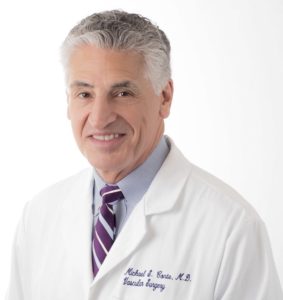
Having observed a strong relationship between calcification and subsequent limb loss, a research team led by investigators from the University of California San Francisco (UCSF) have conducted a single-center, retrospective follow-up extending an initial study evaluating pedal medial arterial calcification (pMAC) score and major amputation in patients with chronic limb-threatening ischemia (CLTI).
Presented at the 2023 winter annual meeting of the Vascular and Endovascular Surgery Society (VESS) in Whistler, British Columbia (Feb. 23–26), by Shant Vartanian, MD, senior corresponding author and associate professor of vascular surgery at UCSF. Michael S. Conte, MD, professor and chair in the division of vascular and endovascular surgery at UCSF, was also a senior author in this research. Speaking to Vascular Specialist, both Conte and Vartanian discussed the team’s findings.
The data suggest pMAC could become a “robust” marker for hemodynamic response to revascularization and risk of limb loss, and have the potential to better inform healthcare professionals on the most suitable treatment pathway, Conte said.
In their initial study, Vartanian and colleagues found that by measuring the extent of calcium buildup in the foot arteries, a higher incidence of limb loss risk was noted. However, as Conte admits, the calcification pattern is not something vascular specialists routinely consider when planning an intervention. This is unless the patient is diabetic or has kidney disease, which vascular surgeons are seeing “more and more,” he says—noting an increasing number of patients are presenting with “distal” and “challenging-to-treat” disease, extending beyond the calf and into the ankle and foot.
Adding to this, Vartanian recalls their initial intention was to study wound healing in correlation with disease severity, however difficulties investigating this retrospectively steered the investigators to focus on a “clean endpoint”—that being the relative contribution of below-ankle disease and outcomes in CLTI after revascularization.
When conducting a subsequent retrospective review, the team included 306 patients who had a technically successful index infrainguinal revascularization for CLTI between January 2011 and December 2020. They defined technical success as restoration of in-line flow through the target artery pathway into the foot. Furthermore, pMAC scores were blindly calculated by a single reviewer using two-view minimum plain foot radiographs and were subsequently classified using the Society for Vascular Surgery (SVS) WIfI staging system.
The revascularization approach was open bypass in 118 (38%) and endovascular in 188 (62%) patients, their results showed. The pMAC scores were trichotomized (0–1 [125; 41%], 2–4 [116; 38%], 5 [65; 21%]). In the bypass subgroup, the researchers state WIfI ischemia grade was improved in 35 of 46 (76%) patients—a total of 19 of 118 (16%) receiving major amputation—although data were not associated with pMAC scores. In the endovascular subgroup, WIfI ischemia grade was improved in 43 of 90 (48%), however 37 of 188 (20%) underwent major amputation.
Drawing conclusions from these results, Conte and researchers directed attention to the “selective differences” in the impact of pedal arterial calcification on revascularization outcomes in CLTI. Although pMAC score was “strongly and independently” associated with failure to improve WIfI ischemia grade after infrainguinal angioplasty or stent, the authors identified no factors associated with this outcome in those who underwent bypass.
“[Our results] at very least can help healthcare professionals discuss the odds of success with their patients, and rethink how aggressively to push for revascularization, or certainly have in mind that a standard revascularization may not work for a patient with a high pMAC score,” Conte explained. In concurrence, Vartanian noted that it is essential the implications of revascularization be studied prospectively and ultimately be “factored in upfront decision-making” for the management of CLTI and that measuring pMAC scores is a “simple and efficient” way to quantifying the burden of calcification.
Importantly, Conte noted that although the WIfI stage captures the clinical spectrum of CLTI, the pMAC score can describe the underlying pathology and provides useful information that may serve as an “important predictor of revascularization outcomes. Having been involved in the inception of the WIfI staging system, Conte believes the addition of pMAC scoring would be a “step forward” in stratifying patients with limb-threatening ischemia, delineating who is high-risk and should receive urgent care.
When reflecting on the audiences reception of their presentation at VESS 2023, Vartanian concedes that “cynicism is healthy”—particularly when confronted with a novel concept, noting: “There’s not a robust body of evidence to support [pMAC scoring] just yet. I think it’s natural to ask difficult questions and as cases of below-ankle disease increase, healthcare professionals should be having honest conversations with patients, assessing potential risks.” Distilling his thoughts, Vartanian continues—“I believe the take home message is to reassess adequacy of perfusion, and focus on vigilance short-term, then observation and reintervention sooner rather than later, if a case is not developing on a desirable clinical trajectory.”
Reflecting on the broader relevance of the team’s findings, Conte noted: “Measuring pMAC scores for all comers that are referred for possible limb salvage—rather than looking backwards after receiving a revascularization—could improve assessments and aid in defining treatment strategies for patients with CLTI.”
Looking ahead, Conte and Vartanian are clear that further validation is needed from other centers and larger datasets to define the role of pMAC scoring in producing differences in revascularization efficacy and limb salvage in patients with low vs. high burden of pedal calcification. Contemporary research on this topic is on an “exponential curve” upwards however, Vartanian adds, having spoken to fellow researchers at VESS they became aware of many studies at other institutions that will add to the body of knowledge—“I think we are going to see an explosion of papers on the subject in the next few years”, he stated.












